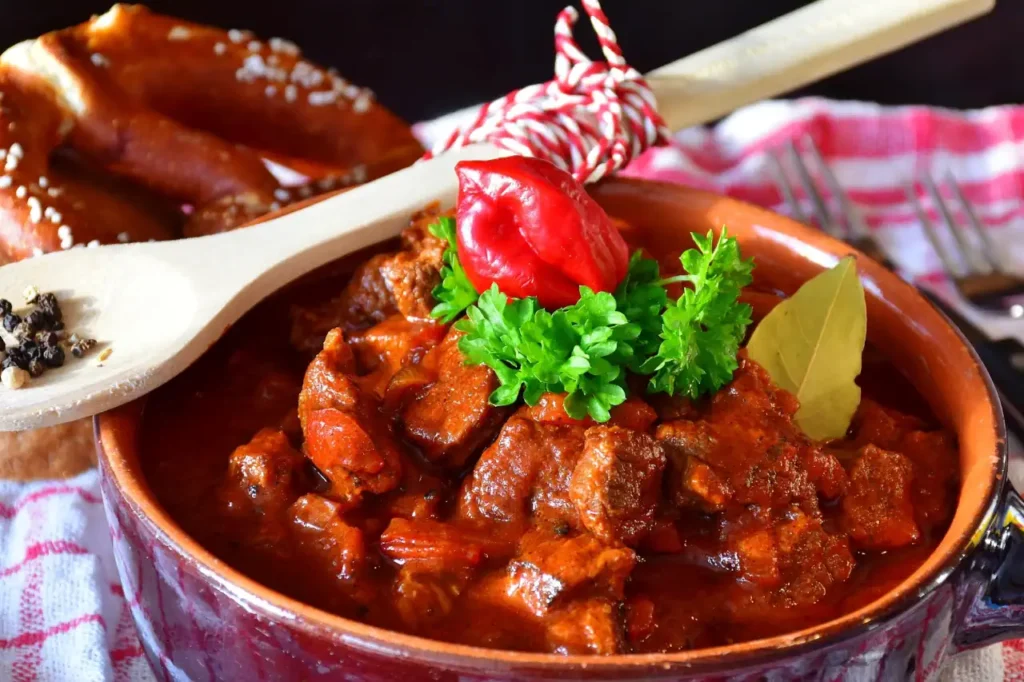A cozy classic you’ll find at German ski huts, Christmas markets, and late-night Imbiss stands. Gulaschsuppe is a paprika-forward beef and onion soup – heartier than a broth, lighter than a stew – with tender beef, sweet peppers, and just enough potatoes to make it a meal. Think: rich, savory, slightly smoky, perfect with a crusty roll.
Though it’s now a German comfort-food staple, Gulaschsuppe traces back to Hungary’s shepherds. Their gulyásleves (goulash soup) which is a paprika-rich soup of beef and onions cooked over open fires – spread through Central Europe during the Austro-Hungarian era. In Germany it evolved into a slightly lighter, spoonable cousin of the thicker stew (Gulasch), with local touches like caraway and marjoram and, in many regions, a handful of potatoes to make it a full meal.
Today, Gulaschsuppe is classic Hüttenkost (mountain-hut fare) and a fixture at Weihnachtsmärkte (Christmas markets), ski lodges, and late-night Imbiss stands – served steaming hot with a crusty Brötchen. You’ll also find giant kettles of it at village festivals and volunteer fire-brigade events, a nod to the old field kitchens nicknamed the “Gulaschkanone”. It’s beloved for being hearty, affordable, and easy to make in big batches – perfect for warming cold hands and happy crowds.
What makes this Goulash Soup “German”?
- Paprika leads. Mostly sweet (mild) paprika with a pinch of hot for warmth – no heavy chili heat.
- Onions in abundance. A near 1:1 ratio of onions to beef by weight builds body and sweetness.
- Caraway & marjoram. Classic German aromatics you’ll taste in lots of hearty soups.
- Spoonable, not thick. It’s a soup with a brothy, glossy finish – great for dunking bread.

Gulaschsuppe
Ingredients
Equipment
Method
- Brown the beef. Pat beef dry and season with a pinch of salt. Heat oil in a heavy pot (Dutch oven) over medium-high. Sear beef in 2 batches until well browned on 2–3 sides, 6–8 minutes per batch. Transfer to a plate.
- Build the base. Lower heat to medium. Add onions and a pinch of salt; cook, stirring, until soft and golden, 10–12 minutes. Add bell pepper; cook 3 minutes. Add garlic; cook 30 seconds.
- Tomato & spice bloom. Stir in tomato paste and cook 1–2 minutes until darkened. Take the pot off the heat, then stir in sweet paprika, hot paprika, caraway, and marjoram (blooming paprika off heat prevents bitterness).
- Deglaze. Return to medium heat; add red wine (if using) and scrape up browned bits. Simmer 2–3 minutes to reduce slightly.
- Simmer. Add browned beef (with juices), broth, bay leaves, 1½ tsp salt, and ½ tsp pepper. Bring to a boil, then reduce to a gentle simmer, partially covered, for 60 minutes.
- Add potatoes. Stir in potatoes and simmer uncovered until beef is tender and potatoes are just cooked, 20–25 minutes more.
- Finish & serve. Fish out bay leaves. Stir in vinegar or lemon juice. Taste and adjust salt/pepper/hot paprika. Ladle into warm bowls and garnish as you like. Serve with crusty rolls or rye bread.
Nutrition
Notes
Tips & Variations
- Beef choice: Chuck is ideal; round works but needs a bit longer.
- Paprika matters: Use fresh, good-quality paprika—if it smells dull, it’ll taste dull.
- Thicker body (optional): Mash a few potato cubes against the pot in the last 5 minutes or simmer 10 minutes longer to reduce.
- Spicier: Swap in more hot paprika or a pinch of chili flakes.
- Smoky note: Add ½ tsp smoked paprika (not traditional but delicious).
- Meat mix: A 50/50 beef-pork combo is common in some regions.
- Gluten-free: This recipe is naturally gluten-free as written.
Make-Ahead, Storage & Reheating
- Make-ahead: Tastes even better the next day as flavors meld.
- Fridge: Up to 4 days in an airtight container.
- Freezer: Up to 3 months. Cool completely, freeze flat. Thaw overnight, reheat gently; add a splash of broth if needed.
Campfire / Dutch Oven Method
- Add potatoes for the last 20–25 minutes and finish as above.
- Use a cast-iron Dutch oven over a steady bed of coals (medium heat).
- Brown beef in batches; move pot to a cooler edge if it runs too hot.
- After deglazing, simmer covered with a few coals on the lid and a small ring underneath. Rotate pot and lid every 15 minutes for even heat.



FAQ
What’s the difference between Gulaschsuppe and Gulasch?
Gulaschsuppe is a soup – brothy, spoonable, great for bread-dunking. Gulasch is a stew – thicker, usually served over noodles or potatoes. Same flavor family (paprika, onions, beef), different thickness.
Which paprika should I use?
Use sweet (mild) paprika as the base and add a pinch of hot paprika for warmth. Smoked paprika isn’t traditional but ¼–½ tsp can add a subtle smoky note. Whatever you use, make sure it’s fresh and aromatic.
Can I skip the wine / make it gluten-free or dairy-free?
Yes. Replace the 1 cup red wine with 1 cup beef broth – no other changes needed. The recipe is naturally gluten-free and dairy-free as written (skip optional sour-cream garnish to keep it dairy-free).
How can I adjust the thickness?
For thicker body, simmer uncovered 10 extra minutes or mash a few potato cubes against the pot in the last 5 minutes. For a thinner soup, add ½–1 cup hot broth or water to reach the consistency you like.
Make-ahead, slow cooker, and freezing tips?
Gulaschsuppe tastes even better the next day. Refrigerate up to 4 days; freeze up to 3 months. Reheat gently and add a splash of broth if needed. For a slow cooker: brown beef/onions first, then cook Low 7–8 hrs (add potatoes in last 45–60 min). Instant Pot: Pressure Cook 30 min, natural release 10 min; add potatoes and simmer on Sauté 10–12 min.


